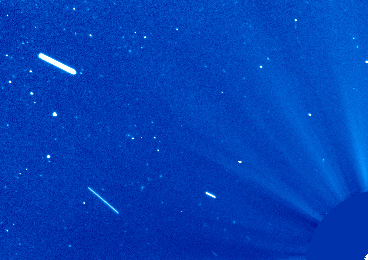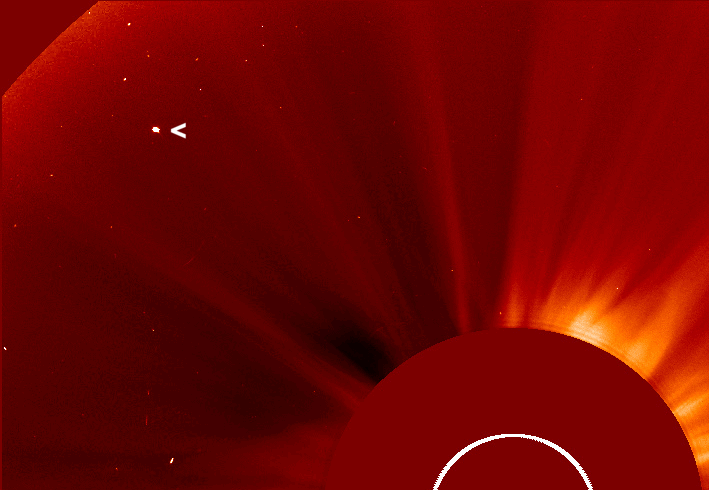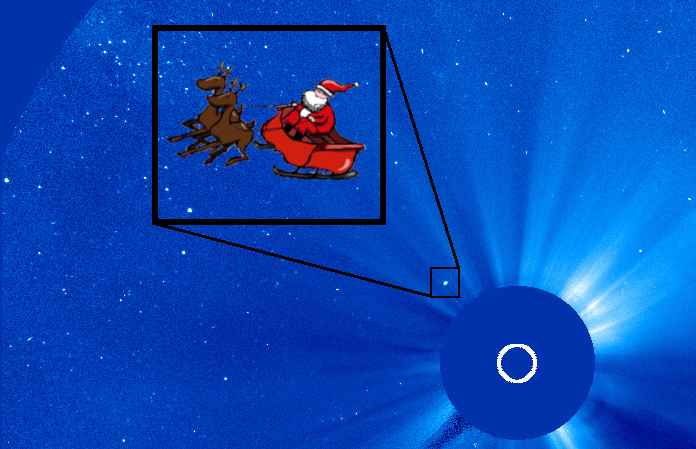Dashing through the sky...
On December 20, 2022, Sungrazer Project citizen scientist Zesheng Yang reported coordinates of an unusual object in the LASCO C2 and C3 fields of view. Having seen and discovered many comets in the SOHO data, Zesheng knew immediately that this was something different, as did we. In fact, in 27 years of operations SOHO has never quite seen something like this, despite having seen it many, many times...
Here is the "object" in question.

The LASCO C3 view on 2022-12-20 from 06:18 through 08:30UT.

The LASCO C2 view on 2022-12-20 from 06:36 through 07:48UT.
What is most notable here, as pointed out by many, is the way in which it seemingly rapidly turns away from the Sun. SOHO has seen literally thousands of comets, some of which do indeed follow a curved trajectory, but not over such short timescales and with such a dramatic curve. So naturally this led to an influx of questions from curious SOHO fans. Fortunately here we have several pieces of evidence that point to a clear (albeit somewhat unexciting) answer: it's just a piece of dust. Here's how we know this:
- SOHO quite routinely sees what we call "debris" images. Here is a pretty dramatic example from 2020 in which we see multiple dust streaks across the image. This is caused by tiny micrometeorites hitting some part of the spacecraft and throwing up a puff of debris. Most likely they are hitting the very fragile thermal insulation blanket around SOHO. These events are quite harmless to SOHO, but the resulting debris can be quite sparkly. How does that relate to this object? Well if we look at the image that SOHO recorded immediately before the feature appeared, we see there was indeed a small debris shower. In fact there was a bright streak in the upper-left that aligns very closely with the first appearance of our mysterious object. So we know for a fact that there was debris in SOHO's vicinity when we recorded the "moving blob" images.
- The curvature of the object's trajectory tells us that it cannot be close to the Sun -- the laws of physics simply would not support that at all because of how far away it would have to be and how bright it is (more on this below). So it must be close to the spacecraft. The only repellant force that realistically could create that curve is the Lorentz force, i.e. a force acting on a charged particle (static electricity, effectively). This holds up really well in our situation because we expect the SOHO spacecraft will indeed have a net charge and a small but non-negligible field around it. Any oppositely charged dust mote coming nearby would most certainly get attracted on a curved trajectory. Indeed, if you’ve been watching SOHO for a number of years, you have very probably seen a number of examples of wavy particle trajectories. It's very common to see, though in these examples it's a single fast-moving particle that is captured in just one ~25-second exposure in one of the LASCO camera. This new one appears in multiple images and in both cameras, making it quite unique.
- So now we will address the question that everyone is thinking: why couldn’t this be a spacecraft (or Santa test driving a new sleigh, which is our preferred alternate reality)? Well, if it was near the Sun, it would have to be truly vast in size to reflect as brightly as it does – like planet-sized – and something like that making its way into the solar system is going to get noticed and reported by a global army of amateur astronomers long before SOHO spots it! And to change trajectory like that at those distances would be a stretch for physics, even for Sci-Fi. Alternatively, if this object was near the spacecraft then it would have to be extremely small or the sunlight reflecting off it would massively saturate the LASCO images. Even if it was (say) ISS-sized and halfway between SOHO and the Sun, it would still be far too large/reflective to show up as a single unsaturated dot, and would still be moving at an entirely unfeasible velocity/trajectory that would quickly make it an easy target for Earth-based observers. Therefore it can only be something close to the SOHO spacecraft, and therefore can only be very small. Given that we mostly see it as a point-source object in a series of 25-second exposures taken about 12-minutes apart, this also tells us that it is moving slow enough to only occupy one or two pixels in each 25-second exposure. Any faster that this and we would see streaking -- much like the proposed first observations of it in which we think we do indeed see it as a streak.
So putting all this together, the physics and optical signature of the feature point almost unambiguously to this being something very small, and very close to the spacecraft (probably within a dozen feet or so). We also have clear evidence that immediately before it appeared, a micrometeorite created a small cloud of debris around the spacecraft, which is an event that happens at least several times per year. This adds up quite conclusively to a very fortuitous observation of a dust speck that by chance stayed perfectly in front of the LASCO C2 and C3 optics for a couple of hours while being repelled from SOHO by the spacecraft's electrostatic forces. Given how many debris images we see in LASCO every year, it’s not at all unreasonable to think that we would see something like this every 27yrs where one of these dust particles happens to remain in view like this for an extended period.
The only other possibility we can think of requires slightly more magical thinking...

Wishing a wonderful Holiday season, and safe and Happy New Year, from everyone at the SOHO and Sungrazer Project teams!
